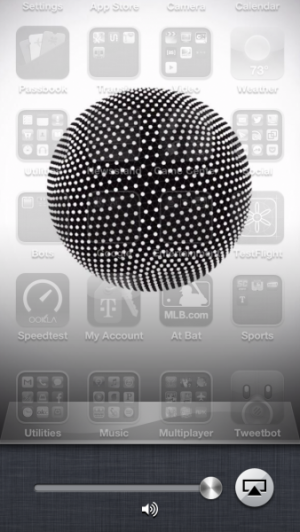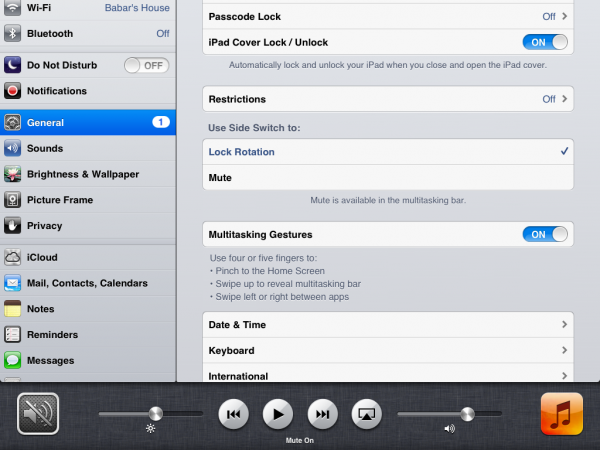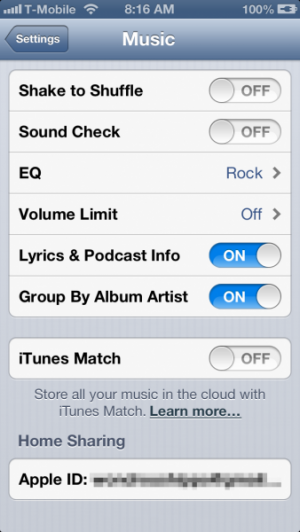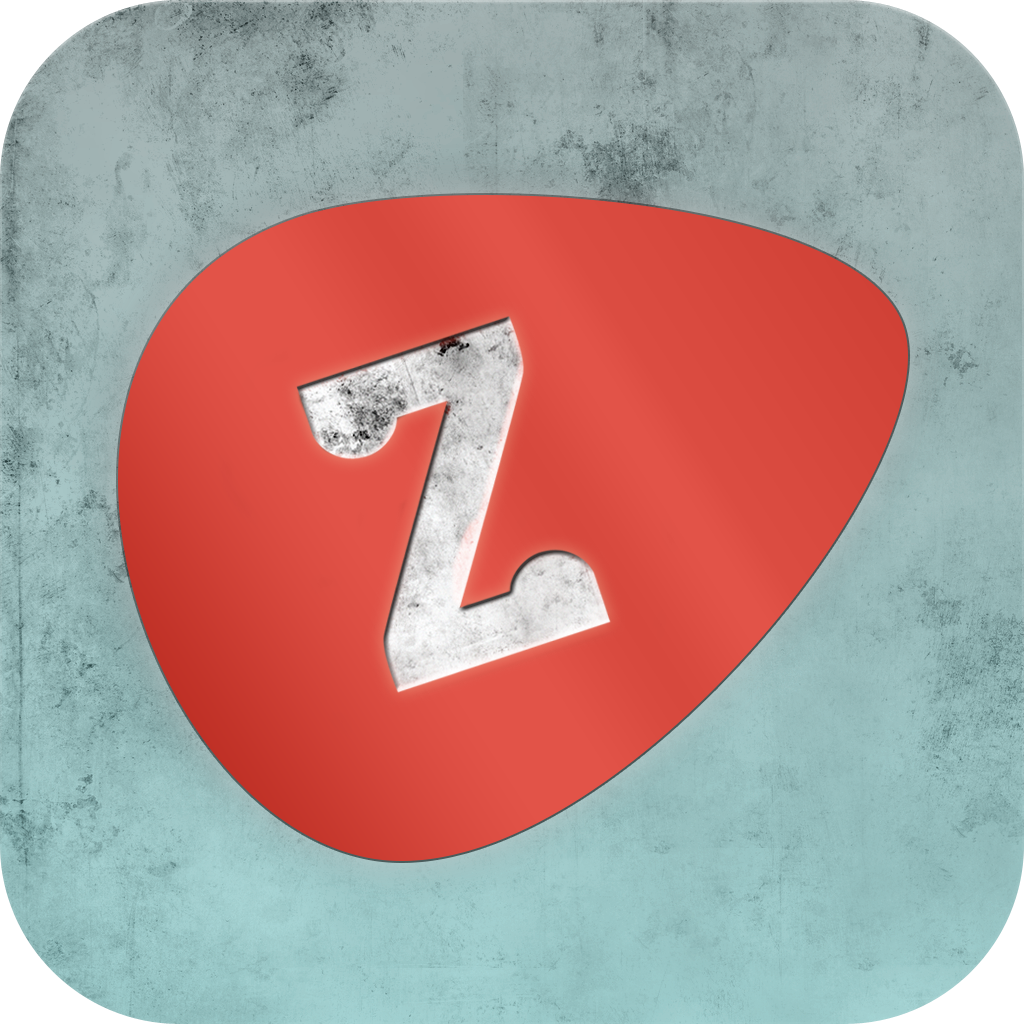Tag: Music »
djay 2 Review
My Muppets Show Review
Pivvot Review
Whitaker Trebella's Long Voyage to Completing His Second Game, Pivvot
Whitaker Trebella, now operating under the company name of Fixpoint Productions for his game and music work, is releasing his second full-fledged game, Pivvot. The development of the game was quite like how it plays: a long and winding path that was fraught with obstacles, but with success waiting at the end.

That was the one thing he just couldn't figure out.
Trebella says that "I struggled for quite awhile with what kind of game I would like to make next. I probably had at least 20 totally different ideas running around in my head, fighting for attention. I sketched out a bunch on paper, prototyped a few on the device, and showed various people a couple of the ideas I had. I really didn't know what I wanted to do for a long time after releasing Polymer."There was one idea that he worked sporadically on at the time, he just never felt all that motivated to work on it because he was struggling to make it work. A talk that Rami Ismail gave, one that wound up influencing fellow Chicago developers such as Dan FitzGerald and Lisa Bromeil of Dog Sled Saga, only helped to sway him toward ditching his idea when he got up to ask about it. His question about whether he should keep pushing with his idea (one he still might pursue in the future) was long-winded, and not exuding much confidence that the idea had a future. "I thought it had potential but it just never struck me. I never had that drive to finish it that I had with Polymer. And because it was a complex idea, it wasn't even fun to play in the early stages. Eventually, I just scrapped it altogether."
So it was back to the drawing board. After scrapping his original idea for his second game, he says "I started making a bunch of prototypes. Out of the many prototypes, I decided on one that eventually led to the creation of Pivvot."
Terry Cavanagh's Super Hexagon "very much so" influenced Pivvot during its creation. "I just really love the simplistic nature of Super Hexagon's gameplay. While it is a VERY hard game, it is VERY easy to understand what to do and how to do it. I wanted to get that same sort of feeling with Pivvot. Someone said to me recently that they enjoyed Pivvot because they knew what to do right away without even playing it. It's back-to-basics gameplay. I was tempted a number of times to add bells and whistles but I kept thinking back to how awesome Super Hexagon is and how it focuses strictly on that one fun mechanic." He even has talked to Terry Cavanagh and says "He seemed to think the idea was cool!" when he showed a version of the game to him a couple of months ago.But curiously, it was also the core technology at work with Pivvot that helped convince him that this was the right idea."I'm working in Unity with the Futile framework. It took me a long time to really understand how to make cool-looking shapes and objects in Futile. Once I figured that out though, it opened up a ton of options. I was able to create cool-looking obstacles, and maybe even more importantly, I was able to create the winding, pulsating path that is the centerpiece of Pivvot's gameplay. Once I had a winding path with some obstacles and some basic collision detection, I was able to play the game and actually have fun."
"Once I was having fun with the prototype, I knew it had potential."
He felt like he had nailed the core idea of pivoting around a point traveling along a winding path avoiding obstacles all the while, but making it fun was the biggest challenge. "It took an incredible amount of playtesting on my end. I would create an obstacle, then play the game over and over and over with just that obstacle until I either felt really happy with it or found something that annoyed me about it. For example, if I kept dying on one specific part of an obstacle and it started to feel unfair, I would make that part a bit easier; if a certain part of an obstacle pattern was just way too easy, I would tweak it to make it harder; if an obstacle played well but just didn't look very cool, I would think about how to make it look better."
Everything with the game's art is actually generated through code. Pivvot has a very minimalistic look, consisting mostly of lines and geometric shapes. This wasn't always the case, though: "the obstacles used to have outlines and other details on them. At first, I thought it looked very cool, but the more I played it, the more I realized the extra details really distracted from the minimalistic look of the game. Having said that, I needed to make sure it looked 'artfully minimalistic' rather than just 'flat.' "
Splyce Review
SessionBand - Piano Edition Review
EarWizard Review
How To: Manage and Master iOS' Volume Settings
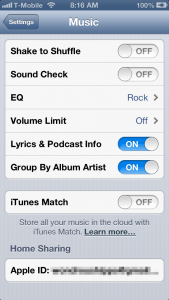
There’s two different volume settings to be aware of: the ringer volume and the sound volume. The ringer volume controls phone ringtones and notification sounds. The sound volume controls the output of sound from games, videos, and music.
Now, it’s possible to control the ringer volume either manually or to have it set to a specific volume. The latter might be handy for those who don’t want to accidentally make their ringer quiet, or just like to have one set volume. Go to Settings->Sounds. Set Change with Buttons to off. Drag the volume slider to your desired setting. Disable Change with Buttons to make the volume buttons always control the sound volume.
Now, music and especially videos run into a fairly annoying problem: they don’t respect the iPhone’s mute switch for playing sounds. Sitting in a meeting, and suddenly that baseball game’s sound starts playing? Awkward! The prevailing thought on Apple’s side seems to be that by playing one of these despite having the silent switch on, that the user wants sound to play. For music, sure, makes sense. For videos, especially live streaming of sports? Nope. Be careful: ensure that the sound volume is muted as well as the ringer volume before starting.
If you want to ensure that you are lowering the sound volume and not just the ringer volume if you have the volume buttons set to control both, double-tap the home button and swipe to the left until you see the volume control. This takes two swipes on iPhone and iPod touch, one on iPad.
This all gets especially confusing considering that the iPod touch and iPad have a virtual mute switch that is all-encompassing, meaning it will quiet music and videos as well. This is available from the multitasking bar as well by double-tapping and swiping left. This is not available on the iPhone, and it will not display on the iPad if your side switch is set to mute. You can configure what the side switch does in Settings -> General.
Finally, the Music section of Settings has some additional olptions for the built-in music app and volume. Sound Check will attempt to level the volume of all songs. Volume Limit will set a maximum volume for listening to music so as to ensure that you don’t blow your ears out with your headphones!
This should hopefully demystify what the different sound settings do. Turn it up to 11! Or don’t.
Space Beats Review
ZAP Guitar - No Strings Attached Review
RokLienz: On Tour Review
Price: FREE
Version: 1.0.1
App Reviewed on: iPad 3
Graphics / Sound Rating:





Gameplay Rating:





Playtime Rating:





Replay Value Rating:





[rating:overall]
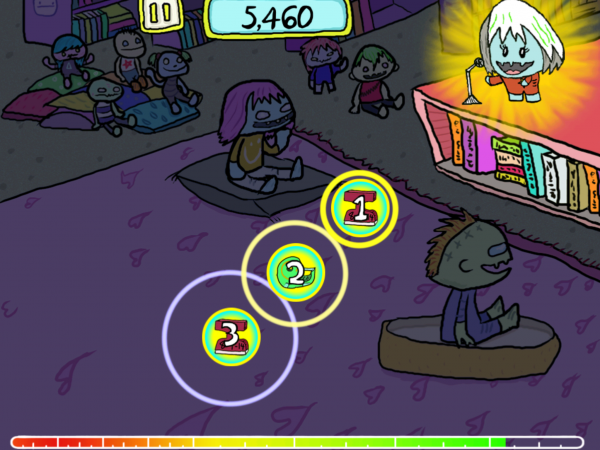
The Roklienz are rockin' aliens (hah, get it?) looking to dominate their home planets with some sweet tunes. Yup, that's right, Roklienz: On Tour is a music game. Not just any music game, but a sort of iPad adaptation of Elite Beat Agents (or Osu! Tatakae! Ouendan for purists). For those unfamiliar with this particular style of music interaction it essentially boils down to following the on-screen prompts. Players have to tap/swipe/spin/etc the right icons in the proper order and in-time with the music in order to keep the crowd happy and complete each level. The better they do the more coins they earn to put towards unlocking and buying new planets, extras, or power-ups.
Roklienz: On Tour's gameplay isn't groundbreaking at this point, but it's still quite excellent. Following all the various prompts in the proper order can become a real challenge in later levels and it all blends together with the music really well. I've yet to need to resort to using any of the power-ups but I can certainly appreciate their presence. Plus I imagine they're more for the kids. And speaking of, I have to say I'm a big fan of the sketchy/scribbly art style. It's simple and there aren't more than a handful of frames for each animation, but there's a distinct personality shining through all those colorful critters.
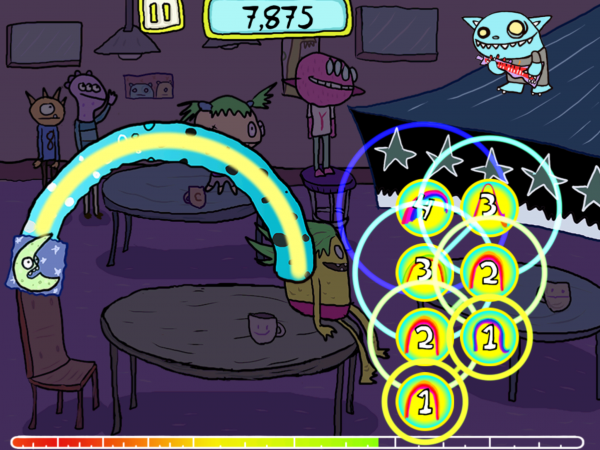
While I would have preferred having a way to "fast-forward" to the more difficult stuff, I still had fun with Roklienz: On Tour. It's silly and doesn't take itself too seriously, yet provides a lot of unlockable content and challenges for those willing to stick it out through the first third.
Spotify Blares Out New Update, Offers New Music Discovery Features
The latest Spotify updates give you a different way to find new music to listen to with the new Discover option. Also, the updated iOS version features a brand-new Now Playing view that shows what's up next in the queue. Spotify also improves and fixes a number of other things, like search tabs, menu button locations, editable playlists on your iPhone, and more.
Start rocking out with these awesome new features!
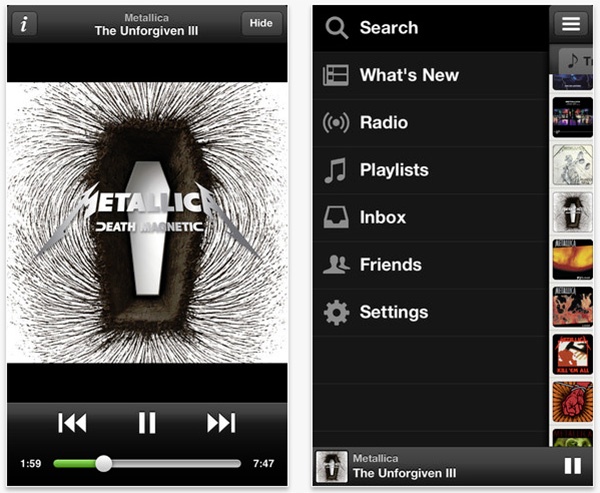
iPro.DJSampler Review
How To: Using OneTrack for Live Music Shows
OneTrack is a great app for musicians who want to take their performance to the stage (review). Here's a quick guide to help those bands get started.
First, bounce live versions of the songs down for play. The best way to do this is to mute the vocals and any other elements that will be performed live, such as guitars or synth parts. Drums are best left in, but much of that depends on the drummer's skill level and how much control they want over their sound. For most drummers, it's best to leave drums in as is, especially if the music relies heavily on loud 4/4 kick beats (at the very least, leave the kick drum in). This is all done in the DAW (digital audio workstation) and depends highly on the software the band uses to compose and record music.
It's also nice to give the drummer a separate click track to help them stay on the beat. An off-beat drummer will completely ruin the show. This is done in the bounce stage within the DAW, and depends highly on the software the band uses to create music. The person responsible for bouncing the live tracks will have to hard pan the click to the left and the music to the right.
The right channel will feed directly to the PA. This is what the audience is supposed to hear. The left will feed to the drummer's headphones. This helps them keep the beat and lead into each song.
After bouncing all live versions of the tracks, the next step is importing the songs to the iOS device. Add all the songs to iTunes and sync them to the iOS device as if adding any artist or playlist to the iPhone or iPod touch.
It's best to add all of the band's songs to the device. Once imported, the band can decide on a playlist for the show. It's always cool do make a few playlists in the app.
The screen below shows the OneTrack playlists screen. The example below shows a sample playlist in progress. The top-right corner shows the total playtime so far, which is 12-minutes in this case.

The "Austin Show" was a special show, so it had its own playlist, but it's good to make a few playlists. Perhaps two 30-minute variations, a 45-minute one and a one-hour set.
Hit the plus sign on the top-left corner and name the new playlist. I would likely go with "30-minute set - 1."
Select a few great songs for the band to play (30 minutes isn't a lot!) and tap the plus sign on the right column. Selected song titles will fade to grey:
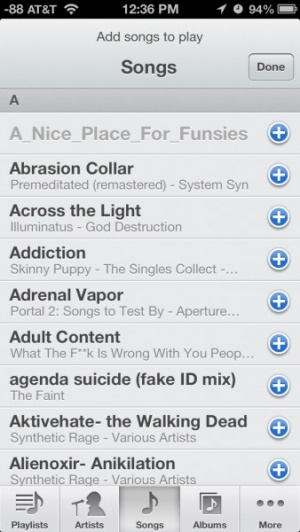
There is room for several more songs. Do keep in mind that it's worth adding a count-in to songs (below):
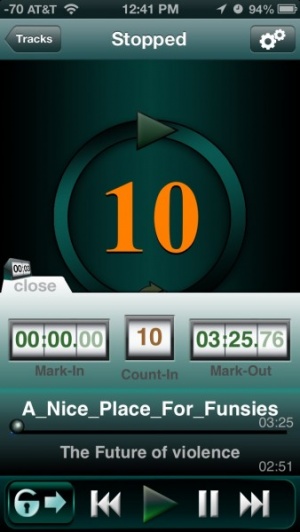
The count-in is basically the quiet space between songs (It's most useful if the band doesn't want to be tethered to the iOS device to queue up the show track-by-track). For instance, a five- to 15-second count-in time is ideal. Don't go too long, or there will be a long, awkward silence between songs. On stage, a few seconds can feel like a long time. It can also add unnecessary dead air to and otherwise great live performance. It's best to make count-ins just long enough for the band to introduce the song, "This next one is called .... " and take a sip of water if needed.
When at the venue, and ready to set up, plug into the mixer. IK Multimedia has a couple of cool cables for this: RCA Output Adapter (right) and Mono Output Splitter (below). Anything similar should work. I carry both, because I never know what the venue will be equipped with.
The mono output splitter looks something like the one below.

A very basic setup should look something like this:
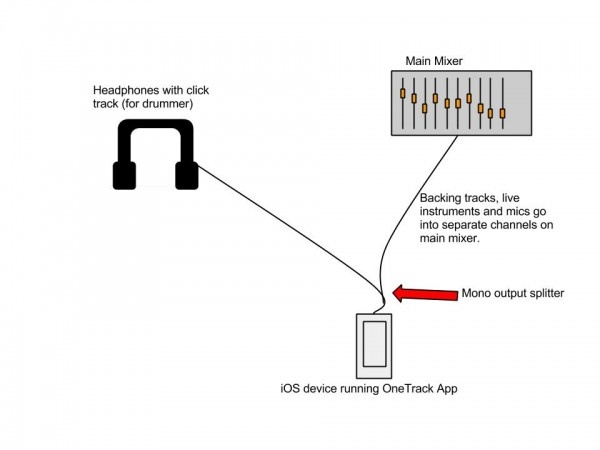
Turn on airplane mode if using an iPhone!
I prefer for the drummer to control the backing tracks, because they are sitting in one spot for the most part, and the drum set kind of covers them. This helps keep the iPhone or iPod touch out of view. It's not a bad thing, but it kind of takes the audience out of the show for a second if they see the band queuing up the next song.
It's important to keep in mind which channel is which as to not accidentally feed the click track to the PA system. Otherwise, the band's epic show will kick off with "click - click - click - click." Not a good first impression. Check, and double-check. Ask for a soundcheck if possible (before the crowd arrives) and leave things plugged in as is after soundcheck. Bands don't always get to do this, but it's nice to make sure things are running smoothly. I usually have a cheesy TV theme song intro, so that the front of house person can adjust levels before my music starts.
Once the music starts blaring through the PA, the show is on. Have fun, and don't mess up too badly!
[gallery]








